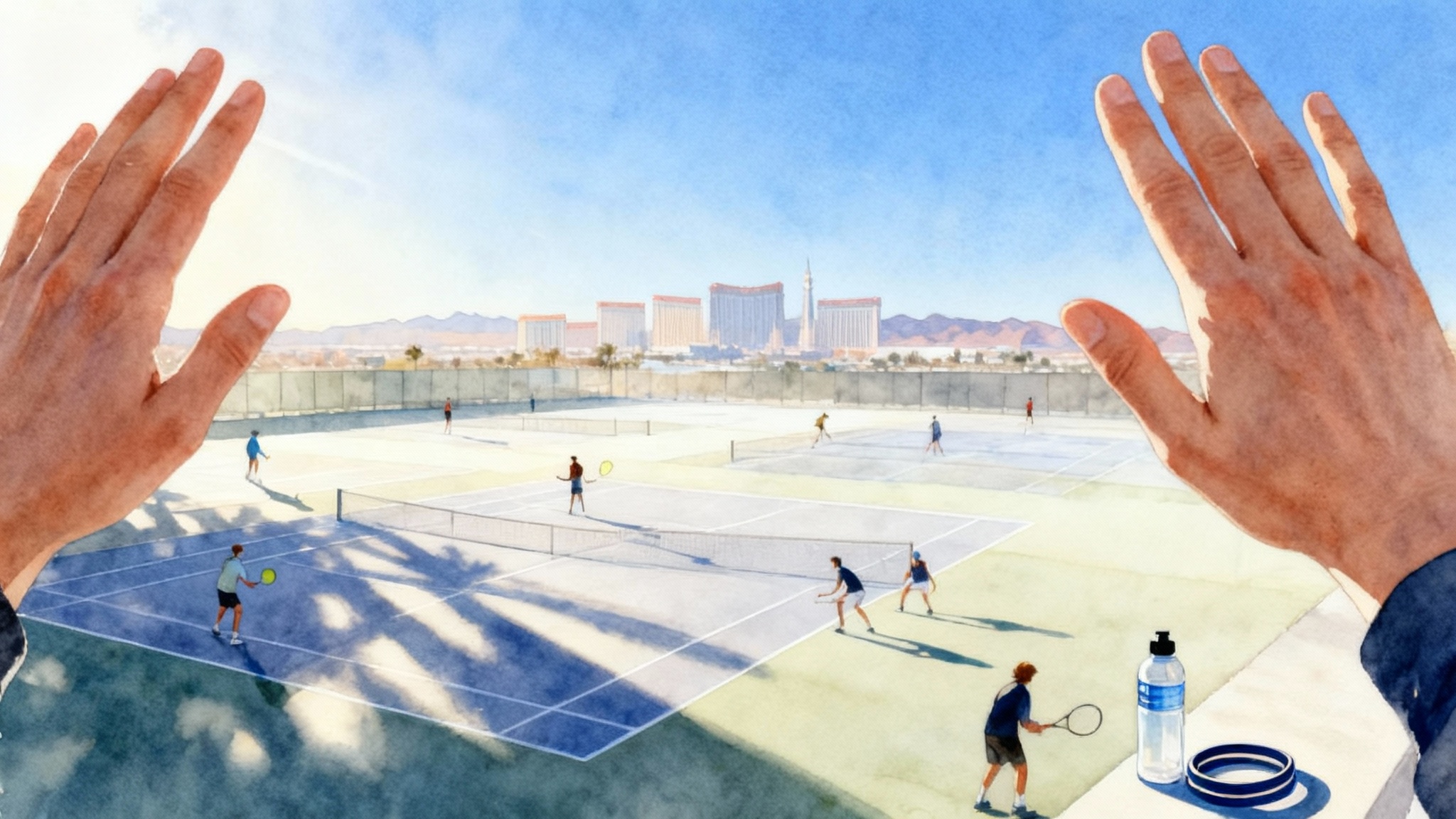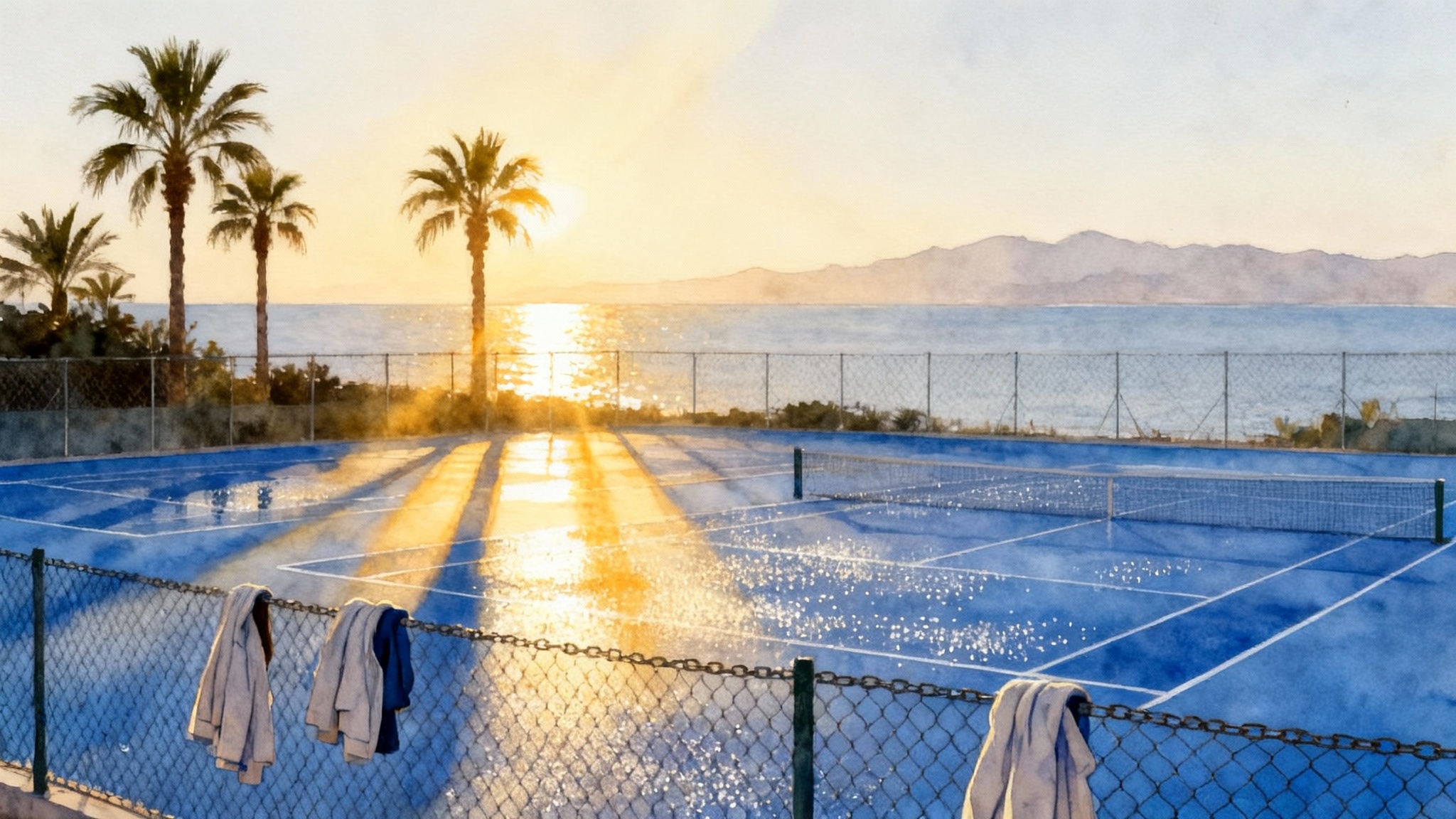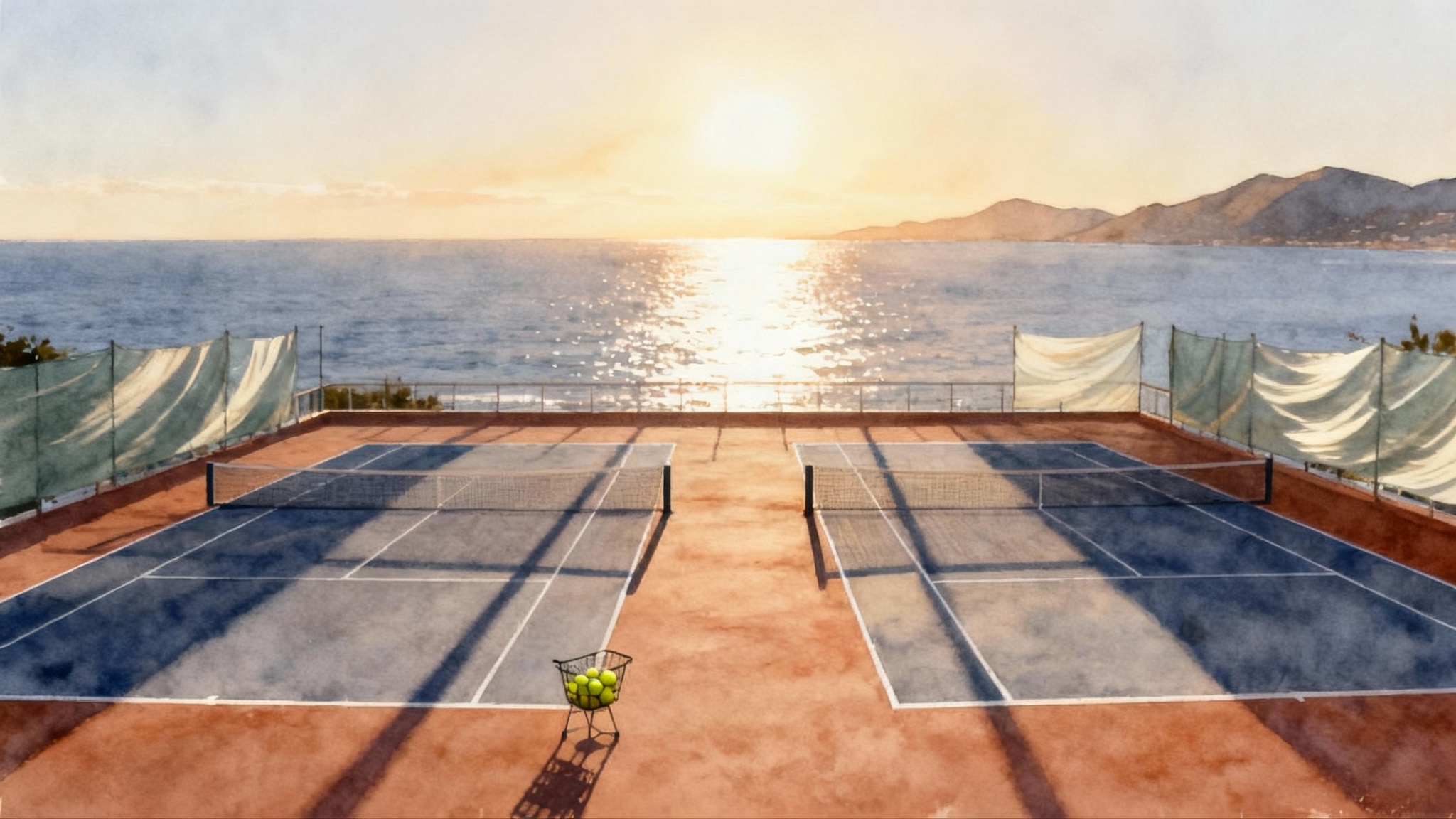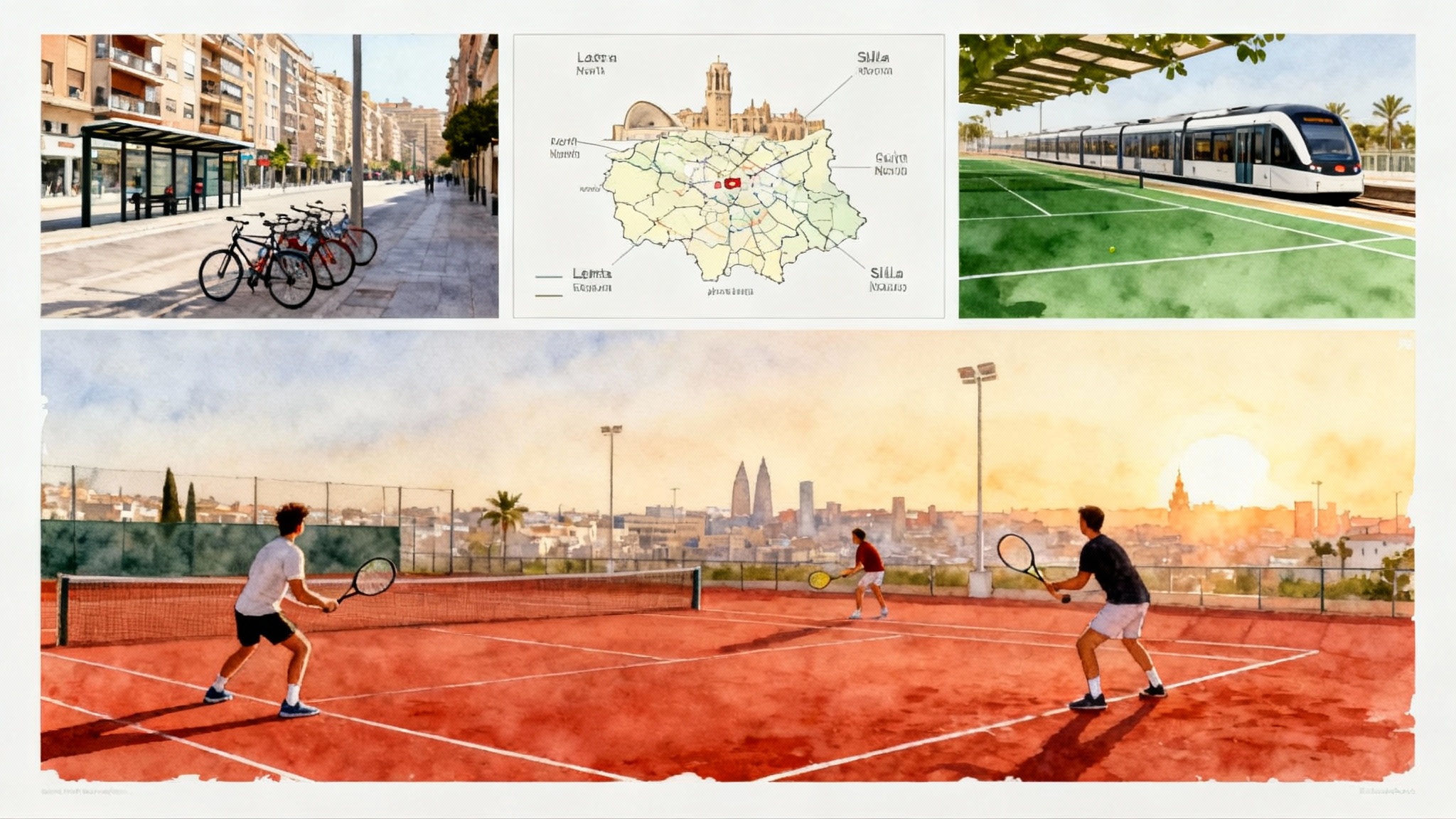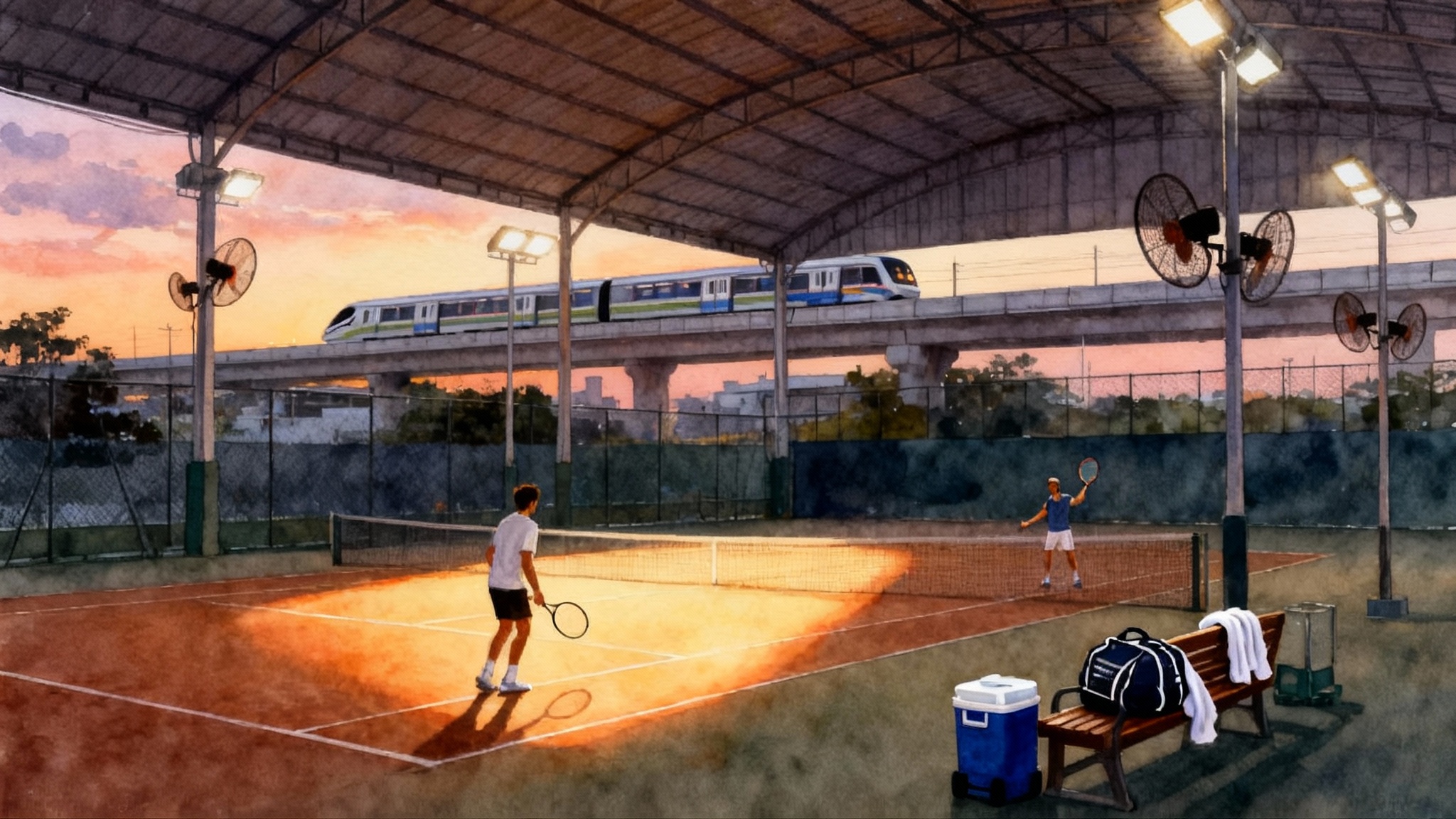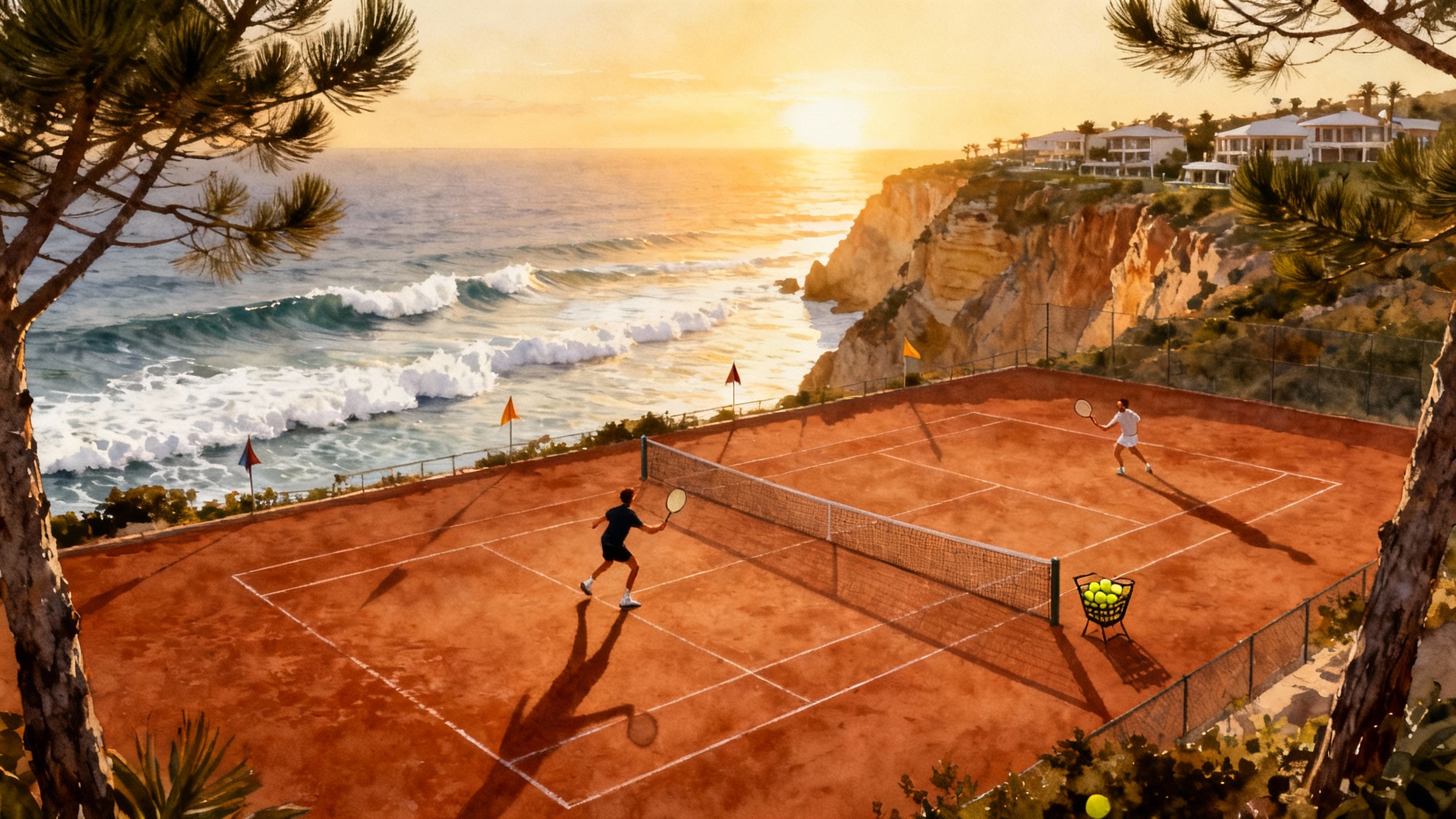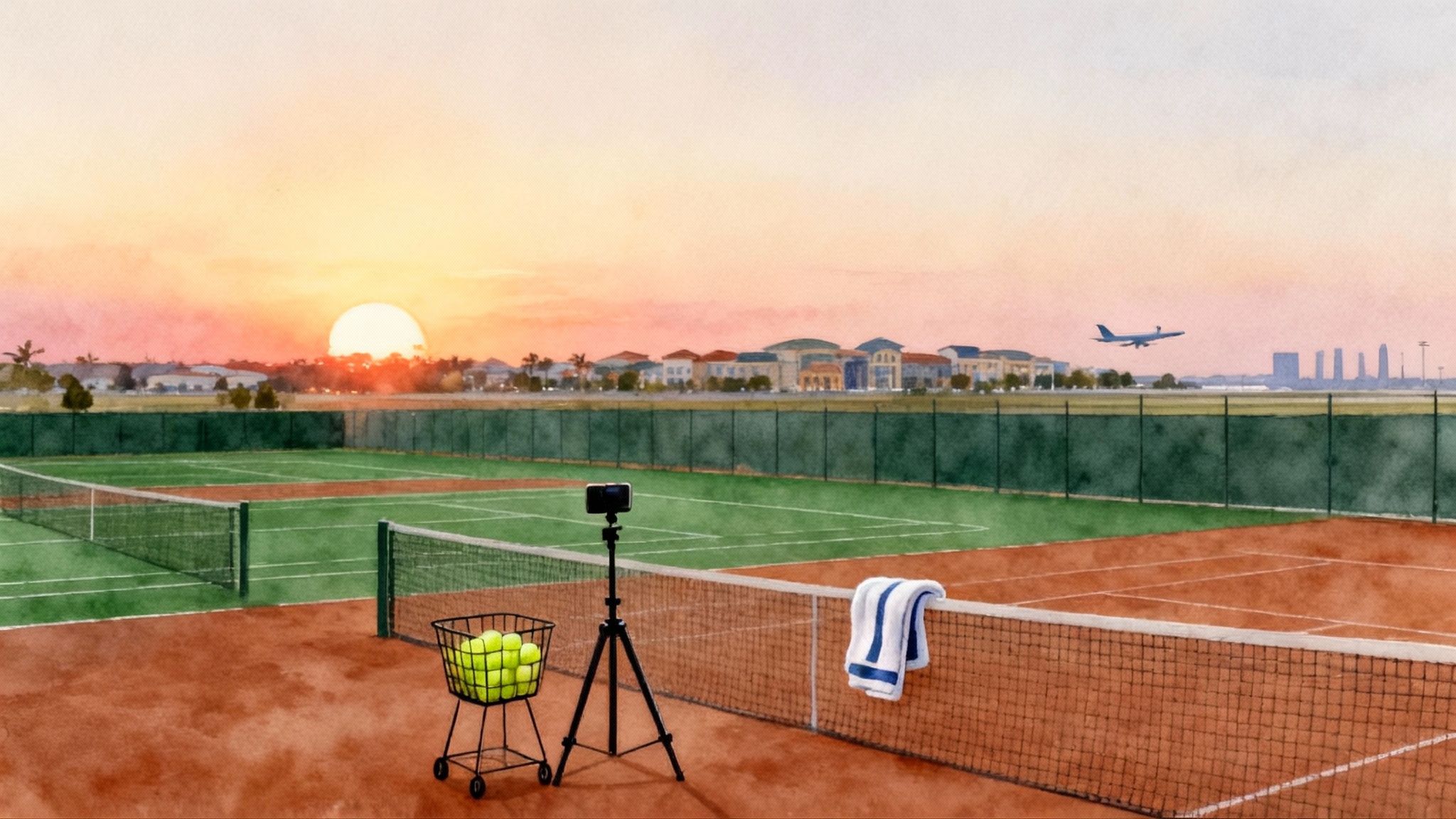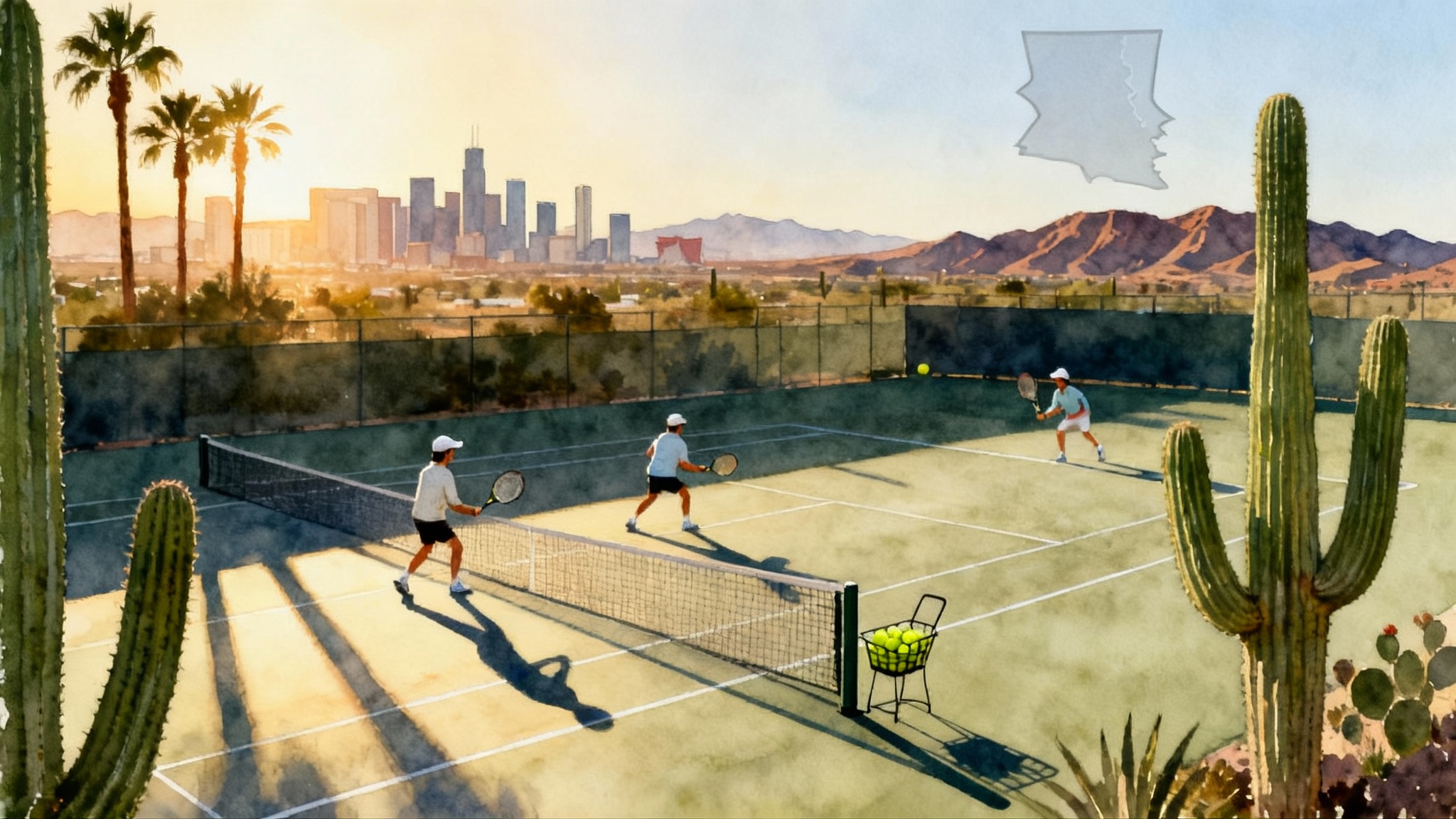Côte d’Azur Winter Tennis: Grasse–Valbonne Microclimate Guide
Train outdoors from December to March in the inland Riviera. This guide explains why the Grasse–Valbonne foothills stay playable, how to anchor your week at Team Eysseric Academy, where to book courts, and how to add family days out.
Why the Grasse and Valbonne foothills work in winter
If you could draw a tennis weather map of the French Riviera, the inland hills between Grasse, Châteauneuf-Grasse, and Valbonne would sit in the sweet spot. They are far enough from the sea to avoid constant damp air, yet low enough on the slope of the Préalpes d’Azur to stay mild. Midday highs in January are typically around 12 to 15 degrees Celsius and climb further by March, which is exactly the range in which clay and hard courts play beautifully. You still get winter showers, but breaks of sun are frequent and frost is rare below the upper terraces.
For a quick reality check, look at the regional climate normals. The nearby Nice station shows January maximums around 13 degrees Celsius and strong annual sunshine, which mirrors what players feel a short drive inland on most winter days. See the official summary of Nice climate normals 1991–2020.
What makes this pocket different is how the hills shape the air. After overnight humidity, a gentle upslope breeze forms late morning, drying surfaces faster than on the shore. When frontal rain pushes through, the first clear sky often appears over the foothills before the coastline. Think of the valleys as shallow bowls that tip out the water quickly; clubs with modern drainage and well-kept clay can reopen soon after a shower while coastal courts may still be slick.
Related planning: If you are comparing winter bases across Europe, see our Valencia climate-smart clay guide and this Tenerife vs Gran Canaria guide for alternative December to March options.
Where you will train
Base yourself at Team Eysseric in Châteauneuf-Grasse. The setting gives you quick reach to Grasse, Valbonne, Mougins, and Antibes, plus the Sophia Antipolis corridor. Coaches here are used to winter microcycles for competition players and to blended squads where one partner prefers clay and another prefers hard. For availability, programs, and contact, see the Team Eysseric Academy profile.
Within a 15 to 25 minute radius you can add municipal and private options in Valbonne, Biot, Antibes, Mougins, and Opio. That mix is strategic. On days after rain, hard courts reopen first. On calm, sunny days, clay is the better teacher for footwork, point construction, and recovery runs.
The microclimate, explained simply
- Hills as a shield: The Préalpes d’Azur sit to the north and northeast. They block the colder air that spills down from higher massifs, so dawn temperatures in the foothills are often several degrees milder than upland stations.
- Fast drying: Winter sun strikes at a lower angle, but the combination of light slope winds and well-drained subsoil helps lift moisture off the surface after late-morning warmup.
- Low frost risk at training hours: Frost happens on clear nights in pockets, but it is unusual from late morning through afternoon below the upper terraces. Scheduling sessions between 11:00 and 15:30 avoids the slickest dew windows.
A practical 7 to 10 day plan
The template below assumes two on-court blocks per day, plus a short strength and mobility routine. Adjust volumes for your level and make day 4 or day 7 a lighter match-play day. Clay and hard are both used to exploit the weather windows.
Day 1, arrival and reset
- Morning: Land at Nice Côte d’Azur Airport, pick up a compact rental car or take public transport to Valbonne or Châteauneuf-Grasse. Check in, short nap if needed.
- Afternoon: 60 to 75 minutes light hit on hard to groove timing, then 25 minutes mobility and core. Emphasis on height over the net and deep crosscourts. Early dinner and sleep.
Day 2, clay feel and patterns
- Morning on clay: 90 minutes. Crosscourt plus line pattern ladders, two-ball approach plus volley recoveries, and 15 minutes of serve targets out wide and body.
- Afternoon on hard: 75 minutes. Tempo set at 70 to 80 percent. First-strike patterns off the return, backhand depth goals. Finish with 6 to 8 sprints of 12 seconds on a gentle uphill lane.
Day 3, serve and return lab
- Morning on hard: 75 minutes. Second-serve height and kick shapes, deuce and ad box sequences. Return reps from both wings, hunting neutral middle.
- Afternoon on clay: 60 to 75 minutes points to 7 with constraints. For example, first ball must land crosscourt inside the singles sideline band. Cool down with band work and ankle mobility.
Day 4, light match day plus scouting
- Morning: Two practice sets on clay if conditions are sunny and dry, otherwise move to hard. Use no-ad scoring to keep intensity high without overloading.
- Afternoon: Recovery. Walk the Valbonne village loop and stretch. If entering a Fédération Française de Tennis event later in the week, use the afternoon to confirm times and location.
Day 5, build the base
- Morning on clay: 90 minutes. Heavy legs day. Deep crosscourt exchanges, high roller forehands, and 2 on 1 defending into the ad corner. Finish with 10 minutes of overhead footwork.
- Afternoon on hard: 45 to 60 minutes spin-density control at moderate pace, then 20 minutes shoulder care. Sleep early.
Day 6, speed and decision making
- Morning on hard: 70 minutes. Short-ball reactions off feed, forehand inside-out to inside-in alternations, transition volley finishes.
- Afternoon on clay: 60 minutes live points from plus-one ball. Work the diagonal first, then pull line only on a balanced step.
Day 7, match play or rest
- Choice A: Enter a one-day Tournoi Multi-Chances if it matches your level. These multi-match formats are common on weekends and ideal for winter. Choice B: If no event fits, scrimmage two sets with a local sparring partner and cut volume by 20 percent.
Days 8 to 10, sharpen or taper
- If staying longer, repeat days 2 to 6 with 10 to 15 percent less total volume, or taper into a scheduled tournament. Prioritize the best weather hours on clay. Keep a backup hard court slot in the late afternoon in case of a morning shower.
Court-booking tips that save your week
- Start with your hub: Ask Team Eysseric to pre-hold key training windows. Many academies keep a protected block for visiting players in winter.
- Use the French system: Most municipal clubs in the Alpes-Maritimes book courts through the Ten’Up platform from the Fédération Française de Tennis. Create or reactivate a profile, then search by town. If you do not see slots online, call the club office. Staff often release additional hard courts after morning inspections.
- Clay maintenance reality: In winter sunshine the top layer can dry mid-session. Plan a 5 minute watering break after the first 45 minutes. Always sweep and brush lines after play. Pack a second pair of socks for the afternoon.
- Floodlights and tokens: Some sites still use tokens for lights. Ask at check-in and buy a few in advance. Evening play is possible, but the best ball feel usually sits in the late morning to mid-afternoon window.
- Bring the right balls: For clay, use regular duty felt. For hard, choose heavy duty to keep the rebound predictable in drier air. If you string rackets yourself, drop tension by 1 to 2 kilograms in colder weeks to keep launch angles constant.
Nearby match play, from FFT to ITF
You have three good paths to real matches between December and March.
- Weeknight and weekend French events: The Fédération Française de Tennis sanctions a dense calendar in the Alpes-Maritimes, including Tournoi Multi-Chances and senior plus categories. Check postings by department. The local committee page is the best starting point for current competitions and venues. See Alpes Maritimes FFT competitions.
- Training matches organized by clubs: Ask Valbonne or Antibes clubs to pair you with similar ratings. French club managers are used to matching travelers with league players in the off season.
- International events as a spectator or tune-up: Late March often brings high-quality junior or pro events to the coast and nearby Monaco. Scouting a day there is both motivating and practical for studying clay footwork.
Licensing note: To enter a sanctioned Fédération Française de Tennis tournament you need a valid license number. Non residents can obtain a license online and link it to Ten’Up. Clubs can advise on the exact steps and medical certificate requirements.
Logistics from Nice Côte d’Azur Airport
- Arrival flow: Nice Côte d’Azur Airport has two terminals. If you are renting a car, pre-book a compact model with winter windshield fluid. The drive to Châteauneuf-Grasse typically takes 35 to 50 minutes depending on traffic and the A8 motorway. Tolls apply, so keep a credit card handy.
- Without a car: Take the airport tram to the Grand Arénas hub, then a regional ZOU bus to Valbonne or Sophia Antipolis, followed by a short taxi to Châteauneuf-Grasse. For early training starts, a car makes life easier, but public transport works if you anchor most sessions at one base.
- Where to stay: Look for small hotels and gîtes in Valbonne, Opio, or Châteauneuf-Grasse to stay near both clay and hard options. Parking is easier than in the coastal towns, and you are closer to forest runs.
Family add-ons that fit a training day
- Valbonne: Morning coffee in the square, a short loop along the Brague river path, and a lunch that still lets you return for a 14:00 hit.
- Antibes: Walk the old town walls, visit the Picasso Museum, then pair a late afternoon hard court session with a seaside dinner.
- Mougins: Stroll the art galleries and sculpture spots. The circular village layout makes an excellent recovery walk.
- Grasse: Book a perfume workshop for non players, then meet on a nearby clay court in the late afternoon when the surface is perfect.
All of these are within 20 to 40 minutes of Châteauneuf-Grasse, so you can keep the training day intact.
Sample daily sessions, written out
Below is a two block outline that you can plug into any day, adjusting for surface and weather.
Block A, 11:00 to 12:30, technical plus patterns
- 15 minutes dynamic warmup and shadow swings
- 25 minutes crosscourt ladder, forehand to forehand, then backhand to backhand, adding direction changes on the coach’s call
- 20 minutes depth cages: must land beyond the service line, three balls in a row to earn a plus-one short ball
- 15 minutes serve: half boxes only, alternating slice and kick, then five deuce plus five ad point starts
- 15 minutes cool down and band work
Block B, 14:30 to 16:00, live play plus fitness
- 20 minutes return plus first two balls, coach feeds serve where your percentage is lowest
- 40 minutes points to 11 with constraints: first point must be crosscourt, no winners allowed before the fifth ball, or server must serve to the backhand
- 10 minutes net rushes with split-step timing
- 20 minutes off-court: hill sprints or short bounding, then long exhale breathing to reset
Backup plan for a passing shower
- Move Block A to hard courts at 13:00 and shorten Block B to 45 minutes. Clay reopens quickly in this microclimate, but hard courts are your insurance.
Budget, booking, and timing
- Court fees: Expect 12 to 25 euros per hour on municipal hard courts in winter, more for indoor options and private clubs. Clay in good sun often carries the same price as hard.
- Coaching blocks: A shared 90 minute high-level session is common among visiting players. Ask about a three or five session package to secure prime hours.
- Tournament entries: Post your availability a week ahead. For Tournoi Multi-Chances weekends, registration often closes by the Wednesday prior. If you plan to play in late March, start looking two to three weeks out.
Gear checklist for inland Riviera winter
- Two pairs of court shoes, one clay, one hard
- Regular duty balls for clay, heavy duty balls for hard
- Light layers, a breathable midlayer, and a thin beanie for warmups
- Sunglasses with amber or brown lenses for glare between clouds
- Compact towel and a spare pair of socks for the afternoon hit
- A soft brush for clay and a small packable squeegee if you train at low-traffic municipal sites
Why this area beats a pure beach base in winter
Coastal courts have the view, but they also hold humidity and sea breeze chill. The foothills give you more playable hours for the same week, greater choice of surface, and shorter drying times after showers. By splitting time between your academy hub and nearby municipal sites, you stack the deck in favor of training continuity.
The bottom line
Winter training here feels like cheating time. The sun takes the edge off the air, the hills do quiet work on the wind, and well-kept clay and hard courts reward anyone who shows up midday with a plan. Anchor your week at Team Eysseric Academy profile, build a simple two block day, and keep a backup hard court in your pocket. Add a weekend Tournoi Multi-Chances if the calendar fits, take your family to Valbonne or Antibes when you recover, and fly home in March with match fitness that usually does not arrive until spring elsewhere. The inland Riviera turns winter into a training season; use it well.
